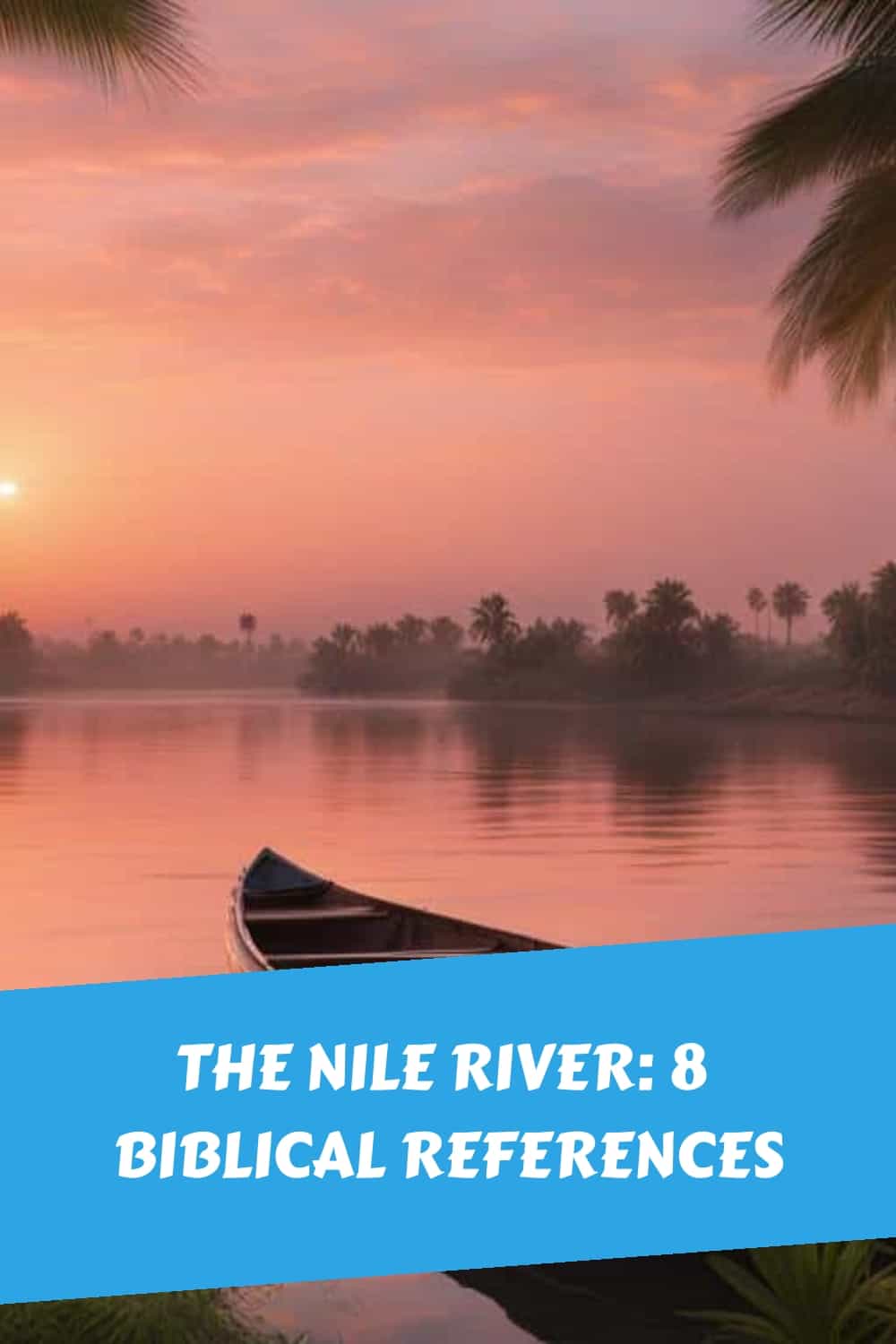Table of Contents
From the moment you read or hear the name “Nile River,” what comes to mind? Its vastness? Its historical and cultural significance? It’s undeniable that the Nile River holds immense importance in ancient civilizations and tales passed down through generations.
But did you know that this mighty river also plays a central role in several biblical events?
Prepare to be amazed as we delve into the biblical significance of the Nile River through 8 scriptural references. Brace yourself, for what you discover may challenge your perception of this ancient waterway.
Now, let’s embark on a journey through time and explore the historical and spiritual influence of the Nile River in various biblical stories. Each reference sheds light on the profound impact this river had on the lives of individuals and entire nations.
Are you ready to uncover the hidden layers of meaning behind these scriptural events?
Discover the awe-inspiring connection between the Nile River and the biblical narratives that have shaped our understanding of history, spirituality, and faith.
The Plague of Blood (Exodus 7:14-24)
In Exodus 7:14-24, God instructs Moses to tell Aaron to stretch his staff over the waters of Egypt, including the Nile River, turning them into blood. This event serves as the first plague upon Pharaoh and Egypt for their refusal to release the Israelites from slavery.
As the Israelites suffered under the oppressive rule of Pharaoh in Egypt, Moses and his brother Aaron were chosen by God to confront the Egyptian ruler and demand the release of their people.
The plague of blood was the first of ten divine punishments unleashed upon Egypt, each more severe than the last, aimed at persuading Pharaoh to let the Israelites go.
This powerful and dramatic event showcased God’s sovereignty and his determination to free the Israelites from their bondage.
By turning the waters of Egypt, including the life-giving Nile River, into blood, God demonstrated his power over creation, leaving the Egyptians without a vital resource and a reminder of their enslavement.
It is important to note that the Nile River holds great significance in Egyptian culture, known as the source of life, fertility, and prosperity. By turning the waters into blood, God directly targeted their beliefs and challenged the authority of the Egyptian gods.
“Let my people go, so that they may worship me. If you refuse to let them go, I will send a plague of blood throughout your whole country, casting your officials, your people, and even the fish in the Nile into a state of horror. The Nile will teem with frogs. They will come up into your palace and your bedroom and onto your bed, into the houses of your officials and your people, and into your ovens and kneading troughs.”
– Exodus 7:14-18
This plague served as a warning to Pharaoh and the Egyptians of the consequences they would face if they continued to defy God’s command to release the Israelites from their unjust enslavement.
It set the stage for the subsequent plagues, each more devastating than the last, finally leading to the liberation of the Israelites and their journey towards the Promised Land.
Moses Found in the Nile (Exodus 2:1-10)
In Exodus 2:1-10, the infant Moses is found in a basket among the reeds of the Nile River by Pharaoh’s daughter, who adopts him and raises him as her own son. This event sets the stage for Moses’ future role as a leader of the Israelites.
Moses, destined for greatness even from his birth, faced certain danger as Pharaoh commanded that all Hebrew baby boys be thrown into the Nile. His mother, driven by love and faith, crafted a basket and placed Moses in it, setting him adrift on the river.
Miraculously, Pharaoh’s daughter discovered the infant among the reeds and was immediately captivated by his presence.
“And when she had opened it, she saw the child: and, behold, the babe wept. And she had compassion on him, and said, This is one of the Hebrews’ children.” (Exodus 2:6)
Pharaoh’s daughter’s compassionate heart led her to adopt Moses as her own, providing him with a life of privilege and protection within the Egyptian palace. This upbringing equipped Moses with the education, influence, and connections necessary to eventually become a prominent leader.
Moses’ adoption into Pharaoh’s family not only delivered him from a life of potential harm but also positioned him to play a crucial role in fulfilling God’s plan for the Israelites.
Little did he know that his journey, guided by divine intervention, would ultimately lead him to confront Pharaoh and become the instrument through which the Israelites would be freed from their enslavement.
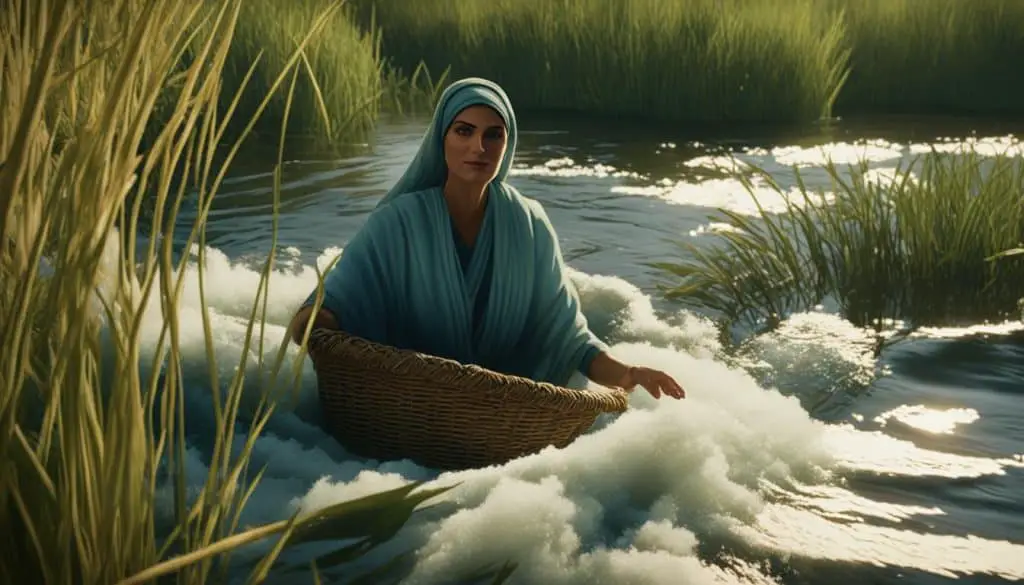
| Key Aspects | Significance |
|---|---|
| Moses | The central figure in the Exodus narrative and the chosen leader of the Israelites. |
| Nile River | The setting for Moses’ discovery, symbolizing both danger and divine intervention. |
| Basket | The vessel that protected Moses and caught the attention of Pharaoh’s daughter, leading to his adoption. |
| Reeds | The location where Moses was placed, highlighting the careful concealment by his mother. |
| Pharaoh’s daughter | The compassionate adoptive mother who plays a pivotal role in Moses’ upbringing and destiny. |
| Adoption | The act that granted Moses security and a position of influence within the Egyptian palace. |
| Leader | Moses’ adoption positioned him to become the leader who would deliver the Israelites from bondage. |
| Israelites | The Hebrew people enslaved in Egypt, for whom Moses would eventually secure freedom. |
The Plague of Frogs (Exodus 8:1-15)
In Exodus 8:1-15, the second plague of frogs descends upon Egypt as a divine sign from God. Aaron stretches his hand over the waters of Egypt, causing an overwhelming torrent of frogs to emerge and cover the land.
This plague of frogs serves as a clear message to Pharaoh, reinforcing God’s demand to release the captive Israelites.
“Then the Lord said to Moses, ‘Go to Pharaoh and say to him, “This is what the Lord says: Let my people go, so that they may worship me. If you refuse to let them go, I will send a plague of frogs on your whole country. The Nile will teem with frogs. They will come up into your palace and your bedroom and onto your bed, into the houses of your officials and on your people, and into your ovens and kneading troughs. The frogs will come up on you and your people and all your officials.”‘”
Pharaoh, initially unyielding, relies on his own magicians to replicate the plague of frogs, only exacerbating the infestation. However, the increasing presence of frogs creates unbearable conditions, rendering the land and its inhabitants virtually incapacitated.
The plague of frogs highlights the power and authority of God, compelling Pharaoh to reconsider his obstinacy and release the Israelites.
It demonstrates that the divine sign sent by God can disrupt the daily life and security of the Egyptians, pressuring Pharaoh to make a significant decision that affects the welfare of his kingdom.
This plague not only manifests in the form of swarms of frogs but also reveals the Lord’s ability to exert control over the natural elements that sustain life. By unleashing this plague upon Egypt’s waters, the divine intervention disrupts the ecological balance and symbolizes God’s dominion over all creation.
This section explores the significance of the second plague – the plague of frogs – as a catalyst for compelling Pharaoh to release the Israelites from their enslavement.
| Frogs | Egypt | Israelites |
|---|---|---|
| Overwhelming infestation | Disrupted daily life | Witnessed God’s power |
| Covered land, houses, and ovens | Incapacitated the nation | Hope for freedom |
| Induced discomfort and fear | Pressured Pharaoh to release | Accelerated deliverance |
Joseph’s Rise to Power through a Dream About the Nile (Genesis 41:1-36)
In the book of Genesis, there is a remarkable story that showcases Joseph’s extraordinary journey from a lowly prisoner to the esteemed vizier of Egypt. This remarkable turn of events begins with a dream about the Nile River.
“Then Pharaoh said to Joseph, ‘Behold, in my dream I was standing on the bank of the Nile, and behold, there came up out of the Nile seven cows, attractive and plump, and they fed in the reed grass. And behold, seven other cows, ugly and thin, came up out of the Nile after them, and stood by the other cows on the bank of the Nile. And the ugly, thin cows ate up the seven attractive, plump cows. And Pharaoh awoke.'”
Pharaoh’s dream leaves him disturbed and seeking an interpretation. Joseph, known for his ability to interpret dreams, is called upon to provide insight into this perplexing vision.
Through divine wisdom, Joseph reveals that the dream represents seven years of abundant harvest followed by seven years of severe famine. His interpretation proves to be accurate and plays a pivotal role in the future of Egypt.
Impressed by Joseph’s interpretation and his character, Pharaoh appoints him as the vizier, responsible for managing Egypt’s resources during the upcoming years of plenty and famine:
“Then Pharaoh said to Joseph, ‘Since God has shown you all this, there is none so discerning and wise as you are. You shall be over my house, and all my people shall order themselves as you command. Only as regards the throne will I be greater than you.'”
This remarkable turn of events not only elevates Joseph to a position of great influence but also allows him to save countless lives during the years of famine. Through his interpretation of Pharaoh’s dream about the Nile, Joseph becomes a key figure in the history of Egypt and the salvation of its people.
Symbolic Elements in Pharaoh’s Dream
| Symbol | Meaning |
|---|---|
| Seven fat cows | Seven years of abundance |
| Seven lean cows | Seven years of famine |
| The Nile River | Source of prosperity and sustenance |
This table summarizes the key symbolic elements in Pharaoh’s dream and their corresponding meanings. The fat cows represent years of plenty, while the lean cows signify the impending years of scarcity.
The Nile River, as depicted in the dream, serves as a symbol of Egypt’s prosperity and sustenance, highlighting its central role in the nation’s agricultural abundance.
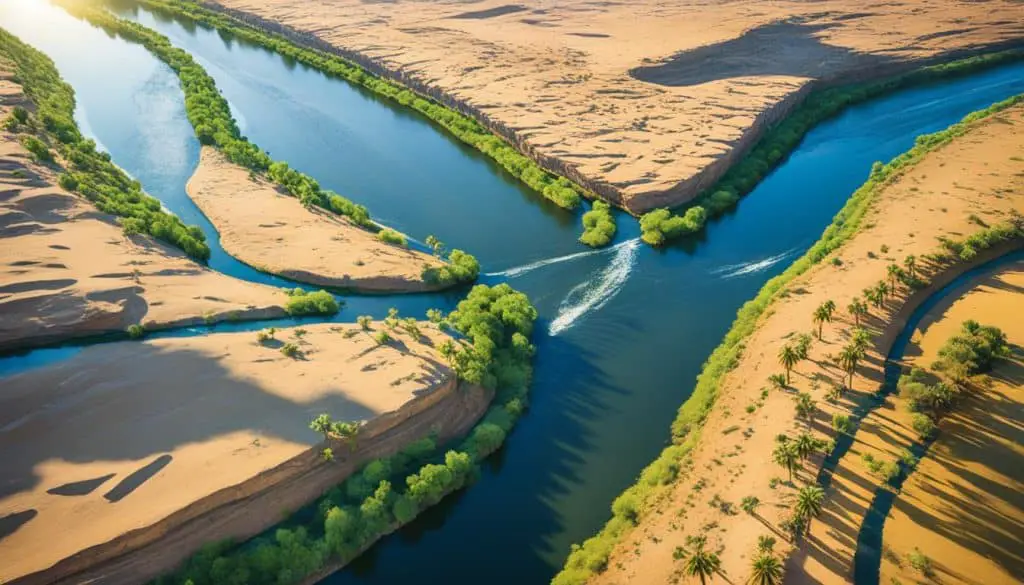
The Nile Turns to Blood in a Vision (Ezekiel 29:1-10)
In Ezekiel 29:1-10, a prophecy against Egypt describes a vision in which the Nile, a lifeline of the nation, turns to blood. This haunting imagery symbolizes the devastating judgment that will befall Egypt at the hands of the Babylonian king, Nebuchadnezzar.
The Nile, revered for its fertility and life-giving properties, is transformed into a source of devastation and desolation.
“Behold, I am against you, Pharaoh king of Egypt, the great dragon that lies in the midst of his streams, that says, ‘My Nile is my own; I made it for myself.’ I will put hooks in your jaws, and make the fish of your streams stick to your scales; and I will draw you up out of the midst of your streams, with all the fish of your streams sticking to your scales. And I will cast you out into the wilderness, you and all the fish of your streams… And when I put you out, I will cover the heavens and make the stars of heaven dark; I will cover the sun with a cloud, and the moon shall not give its light. All the bright lights of heaven will I make dark over you, and put darkness on your land, declares the Lord God.”
The prophecy of the Nile turning to blood serves as a warning of the impending devastation and judgment that Egypt will face. It highlights the profound power and significance of the Nile River in the biblical narrative, as well as the consequences of disobedience and unfaithfulness to God.
Significance of the Nile
The Nile River played a crucial role in the life and culture of ancient Egypt. It was not only a source of sustenance and irrigation for agriculture but also considered a spiritual entity associated with various deities.
The transformation of the Nile into blood represents the stripping away of Egypt’s abundance and prosperity, leaving behind a barren and desolate land.
To visualize the impact of the Nile turning to blood, consider the following table:
| Before | After |
|---|---|
| Lush vegetation along the Nile | Decaying plants and foul odors |
| Fertile soil for agriculture | Infertile land incapable of sustaining crops |
| Abundance of fish in the Nile | Dead fish floating in the blood-filled river |
| Thriving economy due to trade and agriculture | Devastated economy from the loss of agricultural productivity |
This vivid and symbolic imagery depicts the catastrophic consequences that follow the Nile’s transformation from a life-giving force to an agent of devastation.
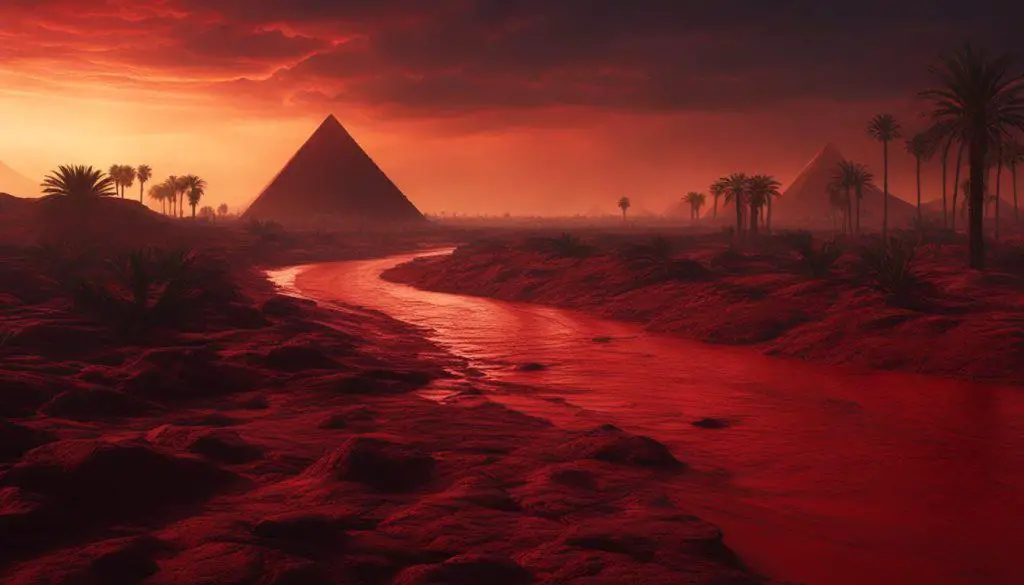
The Blessing of the Nile to Egypt (Isaiah 23:10)
Though not directly mentioning the Nile, Isaiah 23:10 is often interpreted as alluding to the prosperity brought to Egypt by the Nile’s floods. These floods allowed the country to thrive agriculturally.
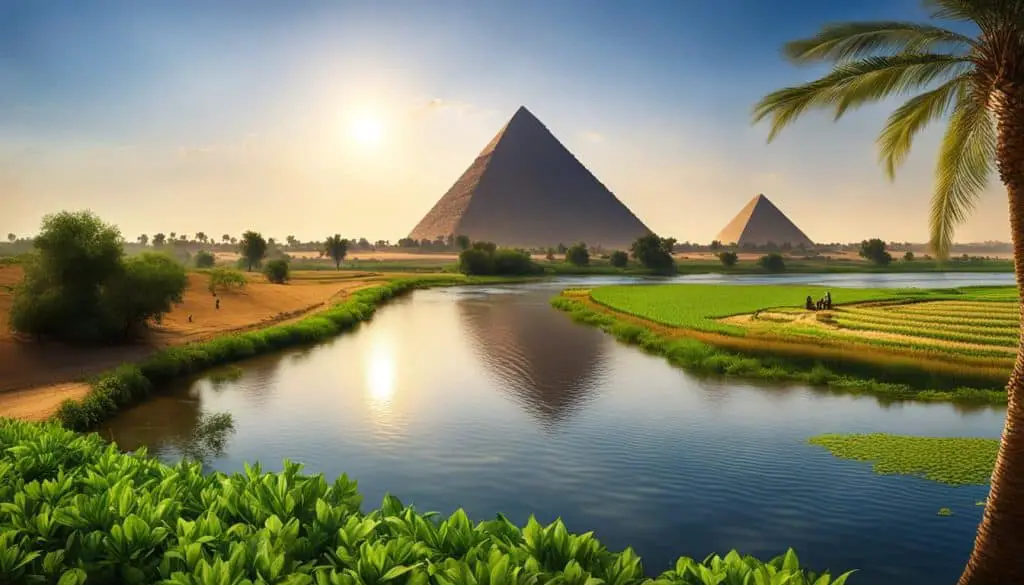
The Nile, an iconic river that flows through Egypt, has long been a blessing to the nation, providing fertile soil and sustenance for its people. Throughout history, the annual floods of the Nile have brought prosperity to the land, enabling a flourishing agriculture industry.
Isaiah 23:10, a verse from the Old Testament, holds significance in illustrating the blessings bestowed upon Egypt through the Nile’s floods. Although not explicitly mentioning the river, this scripture raises the spirits of the Egyptian people, acknowledging the vital role played by the Nile in their economic and agricultural wellbeing.
“Pass through your land like the Nile, O Daughter of Tarshish; there is no longer a harbor.” – Isaiah 23:10
This poetic verse speaks to the metaphorical resemblance between the Nile’s flow and the blessings bestowed upon Egypt. Just as the Nile’s waters overflow their banks, bringing life and fertility, so too does the economic prosperity overflow to the shores of Egypt.
The floods of the Nile, caused by seasonal rains in the Ethiopian Highlands, replenish the agricultural lands along its banks with nutrient-rich silt. This natural process ensures that the soil remains fertile, enabling bountiful harvests and supporting Egypt’s vibrant agricultural sector.
Agriculture has long been the backbone of the Egyptian economy, with ancient civilizations relying on the Nile’s waters to cultivate crops, such as wheat, barley, and flax. The prosperity brought by these agricultural activities not only sustained the population but also attracted traders and merchants from distant lands.

Furthermore, the Nile’s floods also facilitated transportation and trade, allowing goods to be transported easily along the river. This transportation network became a vital link between the different regions of Egypt, further boosting economic growth and development.
From ancient times to the present day, the Nile has been a symbol of blessing and abundance for Egypt. Its waters have sustained the nation, ensuring the prosperity of both its people and its land.
The significance of the Nile’s blessings can still be felt today, as Egypt continues to rely on its beloved river for sustenance and economic growth.
Warning of Nile’s Desolation (Ezekiel 30:12)
In Ezekiel 30:12, a prophecy warns of the Nile’s desolation, a dire message spoken by God. This prophecy foretells the drying up of the mighty Nile River, a devastating event that holds grave consequences for Egypt’s sustenance and economy.
“I will dry up the Nile and sell the land into the hands of evil men; by the hand of foreigners I will lay waste the land and everything in it. I the LORD have spoken.”
These words of warning paint a picture of desolation, as the life-giving waters of the Nile vanish, leaving behind parched lands and a crumbling economy. The Nile River, once a lifeline for Egypt, providing sustenance and prosperity, becomes a symbol of loss and ruin.
The significance of this prophecy extends beyond the physical landscape. The Nile’s desolation represents the withdrawal of God’s favor and protection, a divine judgment upon a nation that has strayed from righteousness. Egypt, once blessed by the abundant waters of the Nile, now faces a harsh reality as its source of sustenance dries up.
For a society heavily dependent on agriculture and the Nile’s annual flooding, this prophecy strikes at the heart of Egypt’s livelihood. The consequences ripple through the economy, affecting not only the agricultural sector but also trade, food security, and the overall well-being of the people.
Egypt’s leaders, its people, and all who witness the fulfillment of this prophecy are left to grapple with the aftermath of the Nile’s desolation. A once-thriving civilization finds itself on the brink of collapse, grappling with the harsh reality of a land stripped of its sustenance and prosperity.
As we reflect on the warning of the Nile’s desolation, we are reminded of the profound impact that the natural world can have on our lives and the delicate balance between human actions and divine repercussions.
The prophecy serves as a timeless reminder of the reverberating consequences that can arise when a nation strays from its moral compass and neglects its obligations to God and the principles of righteousness.
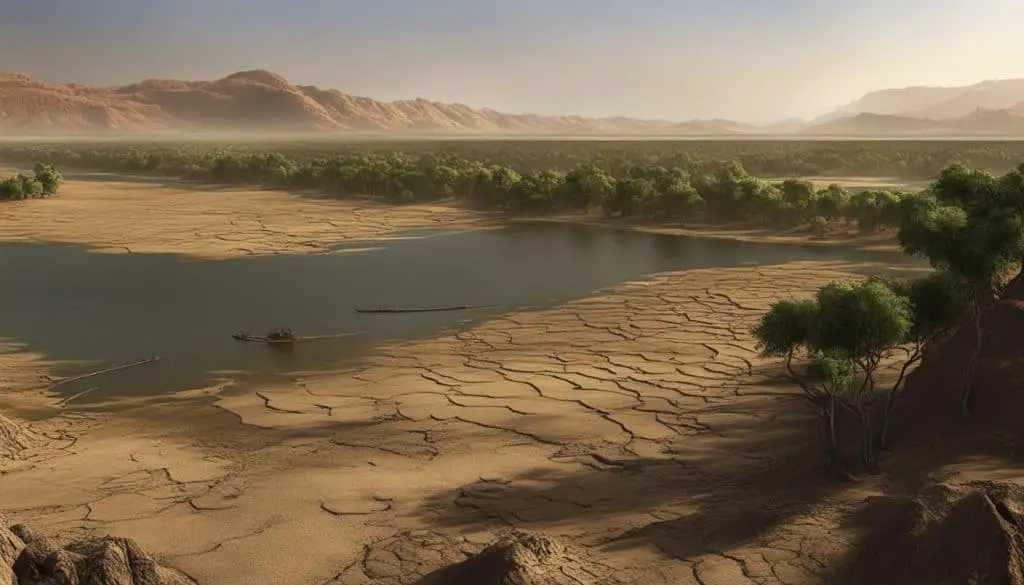
The Nile as a Source of Sustenance (Genesis 41:1-3)
In Joseph’s time, the Nile played a crucial role in providing sustenance, fertility, and abundance to the land. This is beautifully depicted in the dream of the seven healthy cows emerging from the Nile.
The dream symbolizes years of abundance and prosperity that would come to pass. The Nile River, with its fertile banks and life-giving waters, was the lifeline of the region, ensuring the well-being and prosperity of the people.
The Nile’s waters nourished the crops, enabling fruitful harvests and supporting a thriving agricultural economy. The abundance of crops, in turn, sustained the livelihoods of the local population and ensured a stable food supply for the entire region.
| Benefits of the Nile as a Source of Sustenance | |
|---|---|
| Fertility and Abundance | Healthy crops resulted in plentiful harvests and a bountiful food supply. |
| Economic Prosperity | The Nile’s sustenance created a flourishing agricultural economy, supporting trade and commerce. |
| Healthy Cows | The Nile’s nourishment ensured the health and well-being of livestock, particularly cows, which were crucial for dairy products and agricultural labor. |
The Nile’s gift of sustenance went beyond just providing for the physical needs of the communities along its banks. It nurtured a way of life centered around abundance, sharing, and gratitude.
“The Nile, like a benevolent mother, sustained us with its life-giving waters, bestowing upon us fertility and abundance beyond measure.”
The reliance on the Nile for sustenance also fostered a deep spiritual connection between the people and the river. They recognized the divine hand in the river’s blessings and saw it as a symbol of God’s providence and care.
How are the Biblical References to the Nile River related to the Great Flood and Noah’s Story?
The Biblical references to the Nile River provide noah’s great flood insights. In the story of Noah’s Ark, the floodwaters are said to have covered the earth for 150 days. Similarly, the Nile River’s annual flooding was seen as a purification process, linking the two narratives in ancient times.
The River Turns to Blood (Revelation 16:4)
In the New Testament book of Revelation, John has a vision of the end times and the judgments of God. In Revelation 16:4, there is a striking reference to a river turning into blood. While the passage does not explicitly name the river, the imagery strongly echoes the plagues of Egypt in the Old Testament.
Just as the Nile River in Egypt turned to blood in one of the plagues, this vision in Revelation symbolizes God’s judgments upon the earth. It serves as a powerful reminder of the consequences of disobedience and the divine retribution that awaits those who reject God’s authority.
This vivid imagery of the river turning to blood underscores the severity and finality of the end times. It emphasizes the significant role that rivers have played throughout history as vessels for both life and divine judgment. As we consider John’s vision, we are reminded of the eternal consequences that await those who oppose God’s will.


